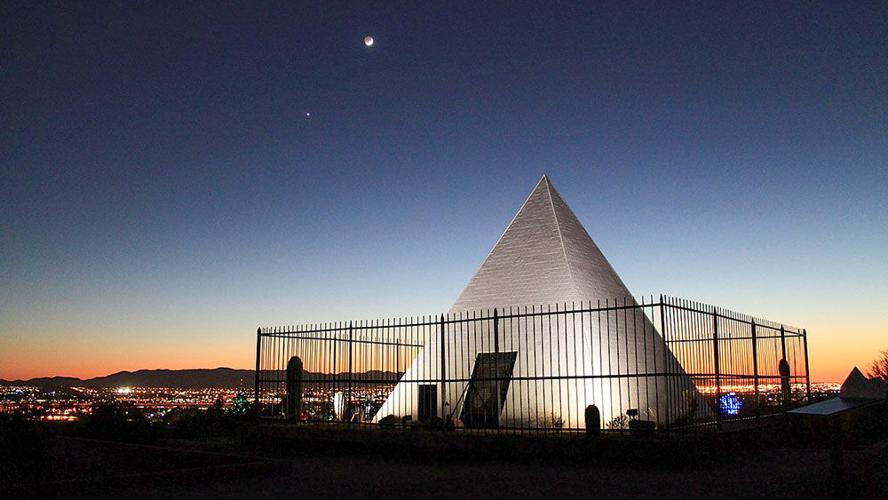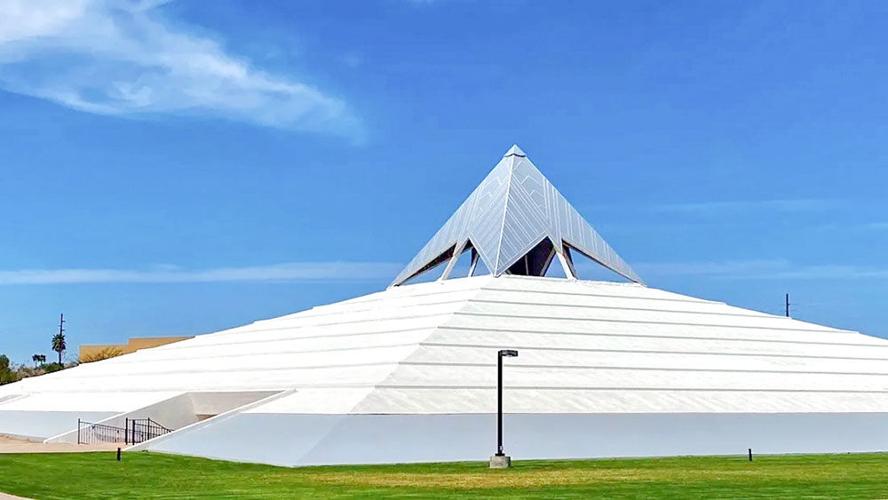Now, here’s an unusual, even rather peculiar situation:
Egypt has lots of deserts. So does Arizona. Egypt is hot and dry. So is Arizona. Egypt has pyramids. So does Arizona. Egypt’s pyramids are bigger than Arizona’s. But Arizona? Arizona has upside-down pyramids.
Like those in Egypt, some Arizona pyramids were erected as monuments to men of distinction, although the Egyptian subjects were far more distinguished than their Arizona pyramid-honored counterparts. King Tut, for example, has a historically larger reputation than a politician named Hunt.
But Hunt’s Tomb does honor the memory of an important Arizona figure. Located on a small hilltop in Papago Park near the Phoenix Zoo, a white concrete pyramid marks the burial site of George West Hunt, Arizona’s first governor. The remains of Hunt’s wife, his mother-in-law, his father-in-law, daughter and son-in-law are also interred on the site.
Another Arizona old-timer gets some present-day respect with a mortared cobblestone pyramid that carves out a lonely existence on a windswept rise north of Florence. It was placed there to honor the memory of Charles Poston, a freethinker often referred to as “the father of Arizona.”
Poston was one of the state’s first elected territorial delegates to Congress, but his popularity dwindled when he proposed building a temple to worship the sun. He died in 1902 and was buried in a paupers’ field. He was reburied under the pyramid in 1925.
And yet another member on the list of Arizona’s historical men of note is honored by a rock pyramid topped by a copper silhouette of a camel. This one guards the remains of Hi Jolly in a cemetery just off the main street of Quartzsite. Hi Jolly came to Arizona from somewhere in the Middle East – probably Syria – as a camel driver for the U.S. Army.
The Army planned to use the camels for military purposes in the Southwest due to their ability to survive in desert conditions, but the experiment failed. Hi Jolly (whose real name was probably Haji Ali, but soldiers changed it to Hi Jolly because it was easier to pronounce) stayed in the area as a gold miner and dray operator until his death in 1902. But his memory lives on. Quartzsite holds the annual Hi Jolly Days; his grave is one of the town’s major tourist attractions.
The building that started as the Capstone Cathedral in north Phoenix is a double pyramid. The structure’s base is a flat pyramid that rises from the desert floor; a smaller pyramid, allegedly modeled after the one that appears on the back of a one-dollar bill, was placed directly in the center of the base. Neil Frisby, a controversial faith healer, erected the building in the mid-1970s and told his followers that the plans came to him directly from God.
When he died in 2005, Frisby’s will left the cathedral to a former professional football player. It sat vacant for several years, then was taken over and remodeled by APEX Sports Camps. It’s located at 4633 E. Shea Boulevard, just west of Tatum.
And now, the upside-down pyramids:
Both Tempe City Hall and the Clancy Real Estate Group offices might give the uninformed the impression that the contractors were standing on the wrong side of the table when they read the blueprints before beginning construction. As a result, the pointy parts are at the bottom of each building, and the bases are the roofs. But, as any good architect would point out, that’s not the case. Both were designed in a style known as “inverted pyramid.”
Those who don’t mind standing on their head to get the proper perspective will find the Tempe City Hall at 31 E. 5th Street and the Clancy building at 3507 N. Central in Phoenix.
— Sam Lowe is A former Valley newspaperman who now writes about his travels across Arizona, the U.S. and the globe.



